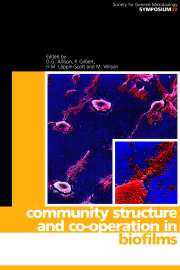Book contents
- Frontmatter
- Contents
- Contributors
- Editors' Preface
- An overview of biofilms as functional communities
- Initial microbial adhesion events: mechanisms and implications
- Physiological events in biofilm formation
- Environmental and genetic factors influencing biofilm structure
- Coaggregation and coadhesion in oral biofilms
- Cohesiveness in biofilm matrix polymers
- Microbial detachment from biofilms
- Modelling and predicting biofilm structure
- Microbial community interactions in biofilms
- Microbial communities: aggregates of individuals or co-ordinated systems
- Gene transfer in biofilms
- Population dynamics in microbial biofilms
- Biodegradation by biofilm communities
- Biofilms and prosthetic devices
- Biofilms: problems of control
- Biofilms in the New Millennium: musings from a peak in Xanadu
- Index
Cohesiveness in biofilm matrix polymers
Published online by Cambridge University Press: 03 June 2010
- Frontmatter
- Contents
- Contributors
- Editors' Preface
- An overview of biofilms as functional communities
- Initial microbial adhesion events: mechanisms and implications
- Physiological events in biofilm formation
- Environmental and genetic factors influencing biofilm structure
- Coaggregation and coadhesion in oral biofilms
- Cohesiveness in biofilm matrix polymers
- Microbial detachment from biofilms
- Modelling and predicting biofilm structure
- Microbial community interactions in biofilms
- Microbial communities: aggregates of individuals or co-ordinated systems
- Gene transfer in biofilms
- Population dynamics in microbial biofilms
- Biodegradation by biofilm communities
- Biofilms and prosthetic devices
- Biofilms: problems of control
- Biofilms in the New Millennium: musings from a peak in Xanadu
- Index
Summary
MICROBIAL AGGREGATES
The vast majority of micro-organisms live and grow in aggregated forms such as biofilms, flocs (‘planktonic biofilms’) and sludges. This form of growth is lumped in the somewhat inexact but generally accepted expression ‘biofilm’. The feature which is common to all these phenomena is that the micro-organisms are embedded in a matrix of extracellular polymeric substances (EPS) which are responsible for morphology, structure, coherence, physico-chemical properties and activity of these aggregates (Wingender & Flemming, 1999). Biofilms are ubiquitously distributed in natural soil and aquatic environments, on tissues of plants, animals and man, as well as in technical systems such as filters and other porous materials, reservoirs, pipelines, ship hulls, heat exchangers, separation membranes, etc. (Costerton et al., 1987; Flemming & Schaule, 1996); biofilms may also develop on medical devices, thus initiating persistent infections in humans (Costerton et al., 1999). Biofilms develop adherent to a solid surface (substratum) at solid–water interfaces, but can also be found at water–air and at solid–air interfaces. They are accumulations of micro-organisms (prokaryotic and eukaryotic unicellular organisms), EPS, multivalent cations, inorganic particles, biogenic material (detritus) as well as colloidal and dissolved compounds. EPS are considered as the key components that determine the structural and functional integrity of microbial aggregates. EPS form a three-dimensional, gel-like, highly hydrated and locally charged biofilm matrix, in which the micro-organisms are more or less immobilized. EPS create a microenvironment for sessile cells which is conditioned by the nature of the EPS matrix. In general, the proportion of EPS in biofilms can vary between roughly 50 and 90% of the total organic matter (Christensen & Characklis, 1990; Nielsen et al., 1997).
- Type
- Chapter
- Information
- Community Structure and Co-operation in Biofilms , pp. 87 - 106Publisher: Cambridge University PressPrint publication year: 2000
- 61
- Cited by



